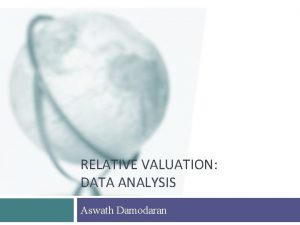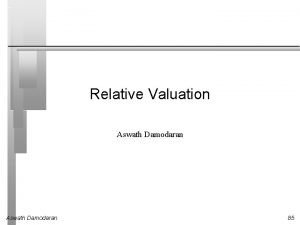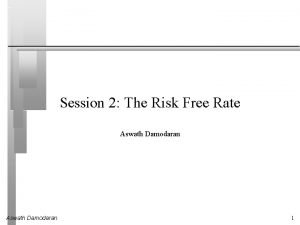RELATIVE VALUATION DATA ANALYSIS Aswath Damodaran Setting the











- Slides: 11

RELATIVE VALUATION: DATA ANALYSIS Aswath Damodaran

Setting the table Sector being assessed: Banks in the US Multiple chosen: Price to Book Ratios Variables that should matter: 1. Quality of growth 1. 2. Return on equity Payout Ratio Expected growth 2. 1. 2. Historic growth Expected growth in EPS Risk measure 3. 1. 2. 3. 4. Beta Standard Deviation Tier 1 Capital Ratio Non-performing loans 2

The Data The raw data on all publicly traded banks was drawn from Capital IQ, with the following screens: Only banks with market cap > $1 billion were considered Only US banks were included Of these banks, I included those banks where I could get Tier 1 Capital and Risk Adjusted Assets The final sample contains 36 banks. 3

Step 1: Descriptive Statistics Compute the standard descriptive statistics for each variable in the data base. You are trying to get a sense of the distribution, not just the high and the low, but also the median and the 25 th and 75 th percentiles. In the process, you are also looking for potential trouble: Abnormally low or high numbers Negative numbers that may throw off your assessment 4

Step 2: Correlations 5

Step 3: Scatter plots 6

Step 4: Regressions: Start with the standard 7

Step 5: Take out the variables that are not statistically significant 8

Step 6: Tweak the regression Try different proxies for growth, risk and quality of growth. See if one of them works. If you have outliers, you can consider removing them but try to be symmetric. If you remove a really high number, remove one that is really low as well. Don’t fight the data. 9

Step 7: The final regression 10

Step 8: Check your predicted values Rank the companies based on actual values for the multiple. Look at percent under or over value for each company, based upon predicted value from regression. See if you get a bunching together of under valued companies near the top of the list and over valued companies near the bottom. 11




















